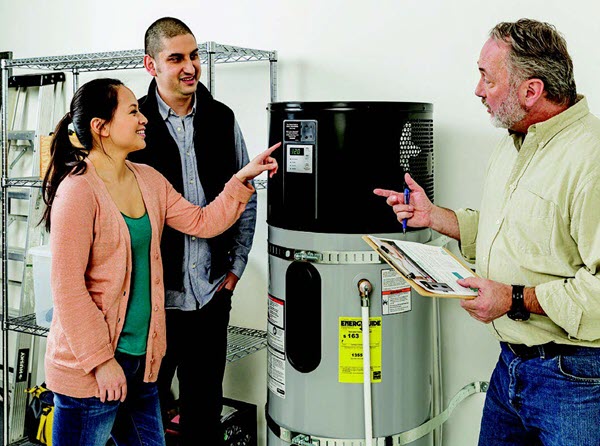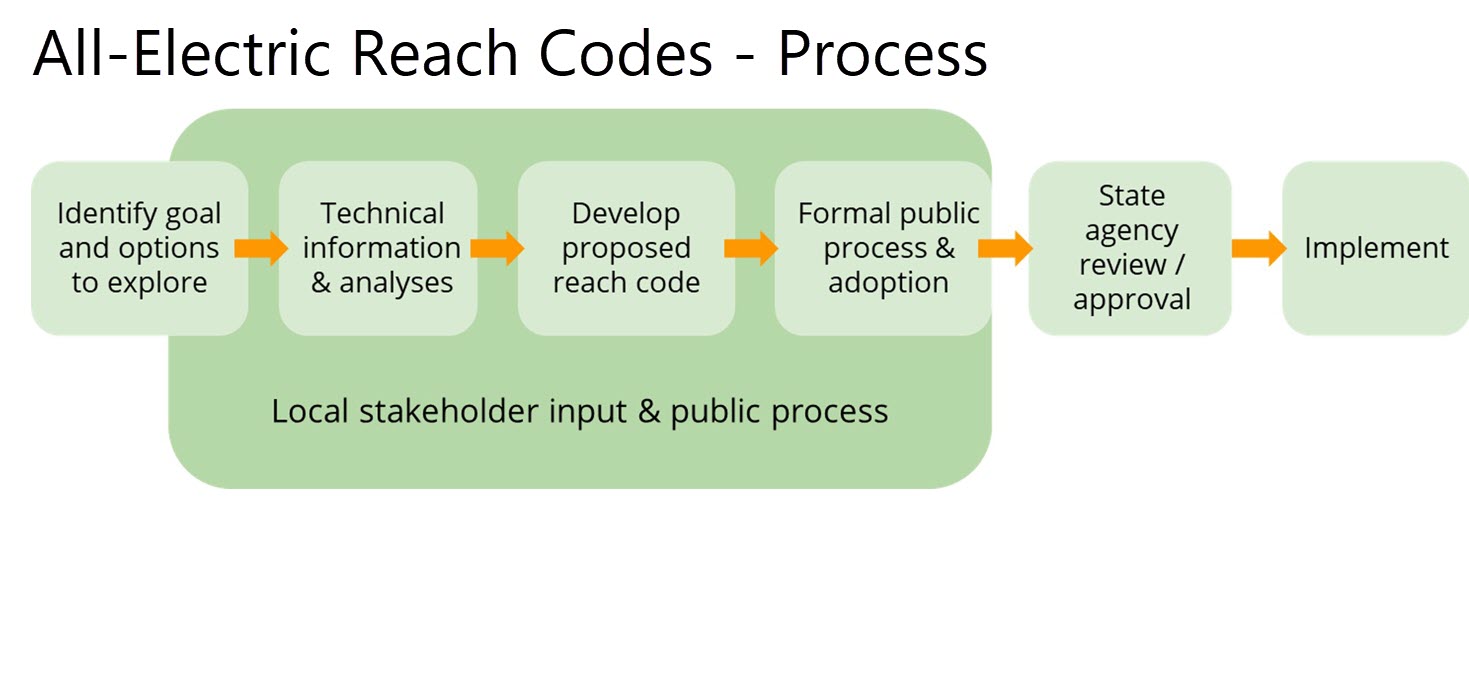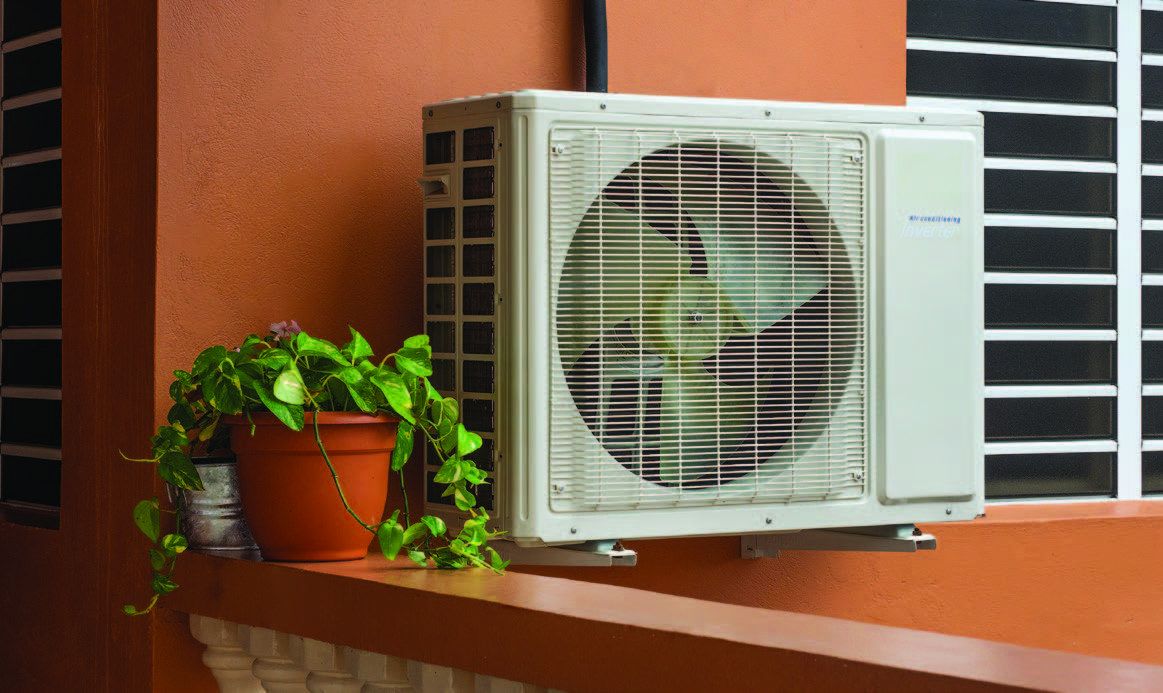Fact: Local governments may also adopt reach codes from the voluntary energy efficiency section of the California Building Code, Title 24, Part 11 (CALGreen), or make other modifications to Part 11. The existing code includes mandatory requirements for electric vehicle (EV) chargers, readiness in newly constructed buildings, and specific additions and alterations. The code also includes voluntary Tier 1 and Tier 2 requirements that jurisdictions can adopt as reach codes. Examples include increasing the percentage of parking spaces required for EV charging or increasing the number of charging outlets.
Reach Codes
Reach Codes
Southern California Edison is committed to carbon neutrality by 2045. As outlined in our decarbonization roadmap Pathway 2045, building codes and standards play a key role in reducing greenhouse gas emissions (GHGs).
Local governments are key partners in reducing emissions, leading the way by recognizing climate change's impacts and passing new building code ordinances, such as reach codes.
The information below is provided for local government leaders interested in developing reach codes and related electrification policies.
Reach Codes
A reach code is a local building energy code that goes beyond or “reaches” past the state minimum requirements for energy use or GHG emissions in building design and construction, usually to address issues such as GHG emissions targets, energy efficiency, air quality, and public health and safety concerns (inside and outside of buildings). Reach codes are not limited to the building sector; they may also involve transportation technologies such as electric vehicle (EV) charging stations in residential and commercial buildings.
Sustainability is integral to our vision to lead the transformation of the electric power industry. Learn More
Building Performance Standards
Unlike building energy codes, which establish minimum requirements during construction or major renovation, Building Performance Standards (BPS) aim to ensure that existing buildings maintain specific performance levels throughout their lifespan. Building Performance Standards require existing buildings to meet increasingly stringent energy or greenhouse gas emission performance targets, typically advancing every 4-6 years to reach specific objectives by a set target year, e.g., 2050. Recognizing the need to develop more resilient, efficient buildings while reducing emissions, some jurisdictions are embracing BPS that mandate performance enhancements across various building types.

Incentives now make these electric heat pump water heaters cost-competitive with natural gas models.
Benefits of Reach Codes and Building Performance Standards
Reach Codes and Building Performance Standards provide an impressive array of environmental, economic, and health benefits:
- Lower GHG Emissions and Climate Impact
- Progress toward Climate Action Plan goals
- Improved public health
- Cleaner air
- Better preparation for local businesses and citizens to meet new state standards
- More affordable buildings
- Safer and more comfortable buildings
- Increased resiliency
- Lower utility bills
- New jobs creation
Templates to Help Cities Design Reach Codes and Staff Reports
Reach Code ordinances and staff reports from jurisdictions that passed reach codes in the region can be accessed at the Statewide Reach Code Program's adopted ordinances page at localenergycodes.com/content/adopted-ordinances.
Statewide Lists of Recent Reach Codes
These groups track recently passed reach codes in California and provide useful information to other jurisdictions researching their reach code options.
- California Energy Commission Statewide Reach Codes Program - localenergycodes.com
- Statewide Reach Codes Program’s matrix, which includes direct PDF links to the ordinances, and their interactive statewide map
- Building Decarbonization Coalition
- Sierra Club (includes jurisdiction agenda links to the ordinances and/or staff reports)
- CEC’s List of Local Ordinances Exceeding the 2019 Energy Code
- CBSC’s List of Local Amendments to Building Standards
Reach Code Myths versus Facts
The topic of reach codes can be complex when you consider all the possible measures and outcomes – and the sometimes-conflicting information promoted by proponents and opponents. Here are some common myths and the corresponding facts that dispel them.
Fact: They are not. A reach code may be considered and passed in two City Council readings within two or three months. It does not require a rigid state approval process. The California Energy Commission (CEC) reviews reach code applications only for minimum requirements at monthly business meetings. Furthermore, some reach codes don’t need any CEC approval. Local jurisdictions that pass reach codes based on health and safety concerns, not energy-related reasons, go through only the simple filing process with the Building Standards Commission. Similarly, reach codes that amend CAL Green* do not require CEC approval.
* Adoption of reach codes by local governments from the voluntary energy efficiency section of the California Building Code, Title 24, Part 11 (CALGreen). Read more in previous Myth/Fact: Reach codes are only amendments to Title 24, Part 6.
Fact: A reach code is flexible—one size does not fit all. While sample ordinance language is available to jurisdictions as a starting point, every reach code can be unique and tailored to a jurisdiction’s particular needs. For example, exemptions can be included for specific types of accessory dwelling units, existing commercial kitchens, and areas where solar access is limited. Cities and counties can tailor a reach code to match their exact needs.
Fact: Reach Codes that modify the energy code must be submitted to the CEC, which requires proof that the reach codes are cost-effective (i.e., less expensive) for customers. To aid this process, the CEC funds the Statewide Reach Codes Program to prepare cost-effectiveness reports that identify cost-effective reach code measures for every climate zone in California. Jurisdictions can simply pick from a list of recommended measures for their climate zone and submit the cost-effectiveness report to the CEC with their ordinances.
Fact: With proper planning, the electric grid can handle building and transportation electrification without reducing grid reliability. The California Public Utilities Commission, the California Independent System Operator, and the state’s electric utilities are continually implementing strategies to avoid outages and shutoffs, such as improved electric system planning, installing additional utility-scale renewable generation and energy storage, and grid hardening upgrades in fire-prone areas. SCE invests approximately $5 billion annually in upgrades to increase grid capacity, improve reliability, and harden the grid against extreme weather events, including wildfires. Reach codes typically focus on new construction. Per the state building code, all new residential construction is required to have rooftop solar. Starting in 2023, all new residential construction is required to have space and electrical infrastructure for future energy (usually battery) storage. Many non-residential building types require both solar and battery installations. These customer-owned resources provide an additional layer of resiliency, on top of the utility-scale enhancements already underway.
Fact: Almost all reach codes are for new construction and do not affect existing buildings in any way. Further, a new reach code for existing buildings would not affect gas stoves; a code would require electric stoves only if the gas stove is replaced during a major retrofit that requires a building permit.
Fact: Serving the electrical needs of all-electric buildings is not a significant concern compared to mixed-fuel buildings. The electrical grid is engineered to handle the highest levels of demand, typically influenced by air conditioning usage in many regions. Research indicates that the peak demand from all-electric buildings is not significantly higher than the peak demand from mixed-fuel buildings in most cases. Some factors supporting grid capability of electrification include:
- Modern electric technologies are very efficient and often are capable of demand response, meaning they can avoid or minimize usage during on-peak hours when the stress on the grid is greatest.
- Communities with all-electric buildings tend to exhibit a more consistent demand for electricity throughout the day.
- Although all-electric buildings may use more electricity overall, their energy consumption is more evenly distributed over time, negating the need for substantial grid enhancements.
Fact: The energy code is updated every three years and yields substantial environmental benefits each time. However, there are always additional cost-effective measures that a jurisdiction can implement to gain further benefits. For instance, electrification of space heating, water heating, or both are proven to yield substantial greenhouse gas emission savings while being cost-effective and maintaining equal performance. Reach codes are worthwhile, and they are an integral part of the code update process because they help accelerate the adoption of cost-effective measures statewide and provide precedent for subsequent code cycles.
There are numerous resources available to local governments interested in pursuing reach codes.
- Statewide Reach Codes Program’s Local Energy Codes
- This statewide program is led jointly by the California Investor-Owned Utilities, including SCE. It is the primary repository of all their reach code resources; much of the content here is derived from there.
- Statewide Reach Codes Program’s Cost Effectiveness Explorer
- The Cost Effectiveness Explorer allows you to enter your jurisdiction, pick possible reach codes, see the savings customized to your jurisdiction, and see supporting materials for Council or Board adoption.
- Reach code process timeline.
- Bay Area Regional Energy Network (BayREN) Reach Codes
- Southern California Regional Energy Network (SoCalREN)
- Tri-County Regional Energy Network (3C-REN)
- California Climate & Energy Collaborative
- Building Decarbonization Coalition
- Southern California Edison, Sacramento Municipal Utility District (SMUD), and the Los Angeles Department of Water and Power (LADWP) funded the Residential Electrification Report of the Building Decarbonization Practice Guide E3.
- Studies about indoor air quality and gas appliances from the Smithsonian, Johns Hopkins, and Stanford.
- The Rocky Mountain Institute published Cost-Effective Grid-Interactive Efficient Buildings.

All-electric, energy-efficient induction stoves are faster, safer, and healthier to use because they eliminate harmful emissions and open flames while keeping kitchens cool.

This reach code development timeline can help shape expectations about the reach code process.
Source: Statewide Reach Codes Program, Reach Codes Newcomers Webinar #1

A heat pump efficiently heats AND cools a home all in one.
SCE Electrification Technology Fact Sheets
SCE provides technology fact sheets on various key electrification technologies or topics:
Related SCE Resources
These additional SCE webpages could help jurisdictions during their reach code-related research.
Incentives & Rebates
These incentives and rebates are available to SCE customers to increase the cost-effectiveness of reducing GHG emissions in buildings.
